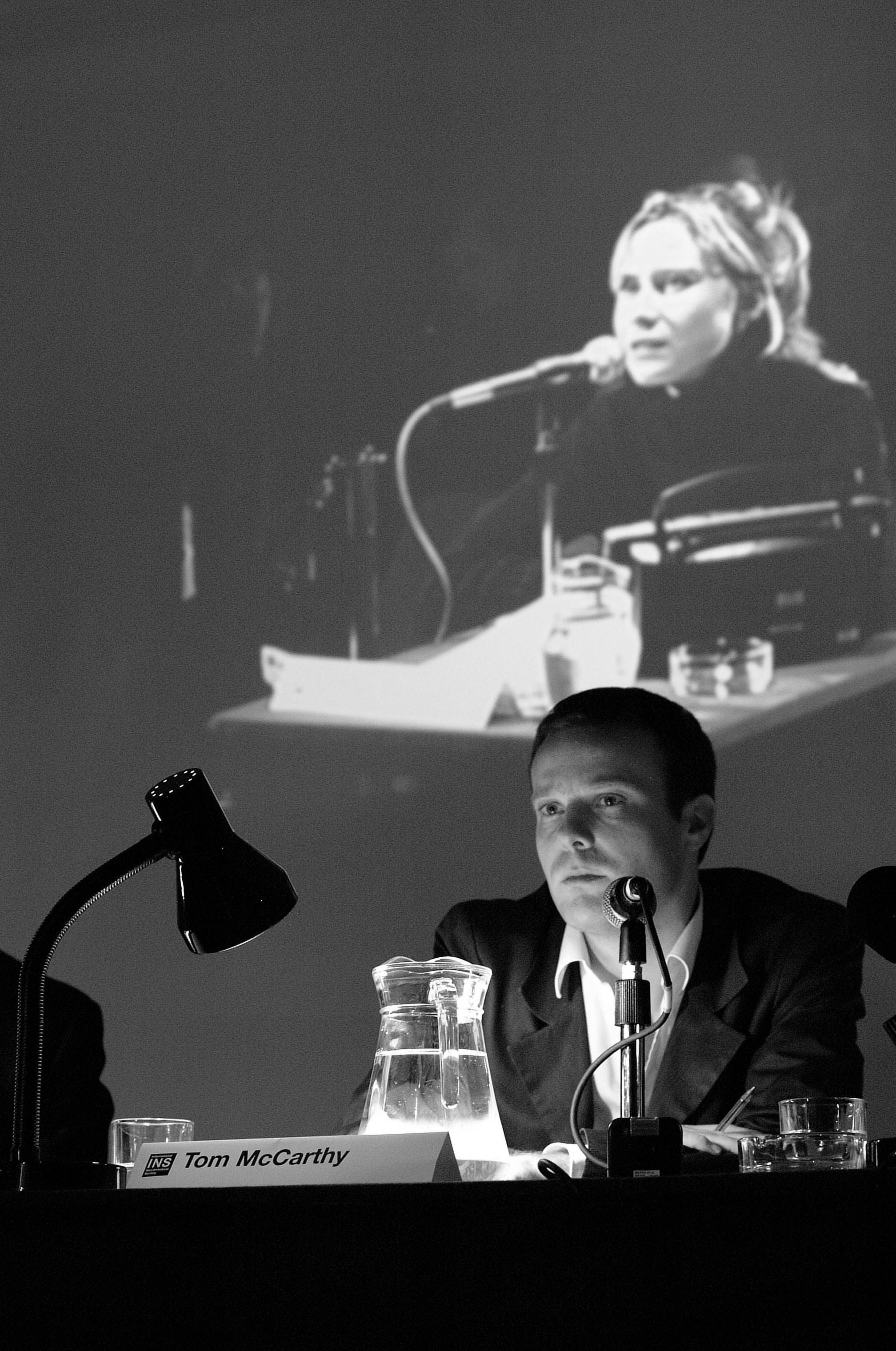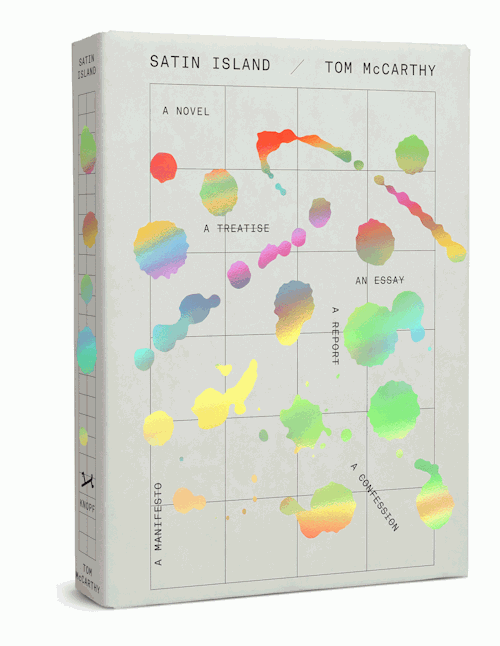Introducing | Tom McCarthy | Writer and Artist
Dylan Cosgrove writes about the work of English novelist Tom McCarthy in the first of a new series of articles in which contributors discuss active and influential authors.
In her 2008 essay “Two Directions for the Novel” from The New York Review of Books, Zadie Smith discusses Tom McCarthy’s then recently published novel, Remainder. She identifies it as a profoundly vital contemporary text. She asserts that Remainder “tries always to acknowledge the void that is not ours, the messy remainder we can’t understand or control—the ultimate marker of which is Death itself”. McCarthy hones in on the motif of inauthenticity as a symptom of the transnational, global society in an attempt to explore this “void.”
Early Life and Other Projects
McCarthy, born in 1969, grew up in central London, studied at Oxford, and then used his limited funds and a British government grant to travel and live abroad. He moved from London to Prague and then to Berlin, working odd jobs as a nude model in an art school, a bartender in an Irish pub, and as a waiter in a restaurant. After Berlin, McCarthy spent time living and working in Amsterdam as an editor for Time Out magazine. In interviews, he discusses how this period of his life exposed him to European metropolitan artist culture and further peaked his interest in the relationship between art and creative writing. He spent his spare time working on what would eventually become Men in Space and Remainder. Now, with two daughters, McCarthy often talks about the difficulty in balancing family with his own time as critical reader, art purveyor and creative developer.
In addition to his work as an author, Tom McCarthy serves as General Secretary of the International Necronautical Society (INF) which is described as a “semi-fictitious organisation.” This organisation began in 1999 and functions as a platform for he and Simon Critchley, a philosopher and close friend of McCarthy’s, to deliver manifestos reminiscent of the early twentieth century avant-garde . These manifestos, combined with the success of Remainder, led to the publication of three more of McCarthy’s novels over the past decade. Men in Space, C, and Satin Island broadly explore the interconnected nature of lives in an increasingly globalised world. Despite initially receiving numerous rejections for Remainder from UK publishers after its completion in 2001, McCarthy’s work has since garnered widespread acclaim. He has received the Believer Book Award for Remainder, multiple shortlistings for his other titles for the highly coveted Man Booker Prize, and one of the inaugural Wyndham-Campbell Literature Prizes from Yale University for his outstanding and innovative work as a fiction writer.
No Future Without Past
If Remainder explores the way in which reenactments and dramatic repetition shape how we now experience the world in a contemporary age plagued by inauthenticity, then McCarthy’s most recent novel, Satin Island, deconstructs that collective experience. The novel’s protagonist, U, is an anthropologist working in England for an ambiguous company tasked with observing and manipulating trends in consumerist culture. U’s main project, self-termed “Present-tense Anthropology,” functions as an attempt at discovering an all-inclusive link that may characterise the contemporary world. He grows infatuated with oil spills and tragic deaths of skydivers. Describing a conference he attends focusing on the role of “the contemporary,” U notes the ambiguous nature of the term. He posits, “Better to speak, I proposed, of a moving ratio of modernity…we straddle the dual territories of a present that, despite its directional drive, is slipping backwards into the past, and a future that will always remain notional” (93). McCarthy’s body of creative work as a whole rests on this “slipping backwards into the past”. He asserts that we must perceive modernity less in terms of futural ends but rather geared more toward repetition and reinterpretations of the past.

McCarthy’s roles both at the INF and as a novelist explore this inherent disjunction between the future and life in the contemporary moment. In the INF’s “Declaration on the Notion of ‘The Future,’” McCarthy and Critchley proclaim, “neoliberal versions of capitalism and democracy present themselves as an inevitability, a destiny to whom the future belongs. We resist this ideology of the future, in the name of the sheer radical potentiality of the past, and of the way the past can shape the creative impulses and imaginative landscape of the present”. This active engagement with the past is precisely what McCarthy does in Satin Island. The narrator is an anthropologist hoping to generalise the present moment but cannot do so without adequate reflection on links to the past. If, as the INF declaration asserts, neoliberalism represents “an inevitability, a destiny to whom the future belongs,” then McCarthy wants readers to resist this capitalistic, futural trajectory in favor of interpreting and characterising the present through its relationship with the past.
The Style of an “Anti-Novel”
Critics sometimes sardonically characterise McCarthy’s work as “anti-realist” or “anti-novelistic,” but he identifies the prevalence and importance of these techniques in some of literature’s most renowned texts. He describes how even Shakespeare portrayed reenactments in Hamlet. His novels express the ways in which memory and authenticity permeate every miniscule, mundane act we undertake on a daily basis. Remainder’s narrator, injured in an undisclosed accident and subsequently compensated heavily by an unnamed, multi-million dollar company, orchestrates dramatic reenactments in hopes of better understanding himself authentically. U in Satin Island watches and re-watches news clips of oil spills to explore the link between natural disaster and art.
Frequent allusions to Beckett, Joyce, Burroughs, Robbe-Grillet and Blanchot in interviews suggest an interest in the intersection between art and everyday life. He opts for notional obscurity and omission in his novels to force his readers to critically engage with his narrators in hopes of better understanding the transnational world we live in. McCarthy’s prose is refined and his structural techniques are often fragmented and stream-of-consciousness-esque. His characters’ dialogue is often contained within large bodies of text without indentation, therefore compartmentalising themes and ideas together instead of separating internal musings from external interactions. In Satin Island, he specifically uses numbered subheadings to denote various episodes, themes or events like an anthropologist organizes a dossier. In this way, his narrative choices are also inherently aesthetic too, as he arranges the text as if mimicking the way his narrator may do so.
Human After All

What McCarthy’s novels may lack in disenfranchised voices, they more than compensate for in the highly philosophical and socially conscious landscapes they portray. He focuses on intuition and the way in which his narrators come to understand, or misunderstand, the world they operate within. His character development stems from his extensive research into both the humanities and the sciences. As he states in an interview with Bomb Magazine from 2015, he reads a multitude of cultural critics while working on each novel. Whether reading Levi-Strauss and Michael de Certeau while writing his latest, Satin Island, or reflecting on the writings of Derrida, Pierre Janet or the avant-garde Futurists while developing his previous novels, McCarthy credits the intimate role fiction holds in parsing out theory and vice versa.
As a graduate student, McCarthy studied and wrote a thesis on Joyce’s Finnegan’s Wake, and he often talks about the way in which Joyce’s innovative techniques influence the development of his own novels. In his article for The Guardian, written last year, McCarthy discusses Joyce’s intentions of creating a culture in writing Ulysses. He comically writes, “If there is an individual alive in 2015 with the genius and vision of James Joyce, they’re probably working for Google”. Neoliberal capitalism, for McCarthy, inhibits the contemporary writer. The prevalence, and dominion moreover, of the market eliminates any manner of newness, as “[everything] is all written down already”.
The age of the Internet not only increases the accessibility of desired source material but also constantly floods the market, and consumers subsequently, with other extraneous data. McCarthy’s novels demonstrate a heightened consciousness of this fact, as his narrators are often concerned with their own sensory makeup and experiences. The culture today already exists outside the novel, so McCarthy and his contemporary peers?unlike Joyce when he wrote Ulysses?must move both against and with the constant and overwhelming current of information and technology.
Despite the cliché and generally inauthentic nature of the word, McCarthy’s work is experimental. Like the great writers that came before him, he manipulates basic human instinct and inclinations to develop thoroughly complex and often chilling narratives. Though, his novels are also characteristically easy to read, thereby making his work accessible to the population of readers not ensconced within academia and literary theory. His language and descriptions mimic and parody the inauthenticity associated with contemporary culture. The narrators are often missing some vital connection with their world, and this only saturates the disjointed, fragmented nature of life in the technological age. Remainder remains his most acclaimed novel, but readers of his later novels will notice the ongoing contribution to his own dialogue between writer, consumer and the contemporary world.

